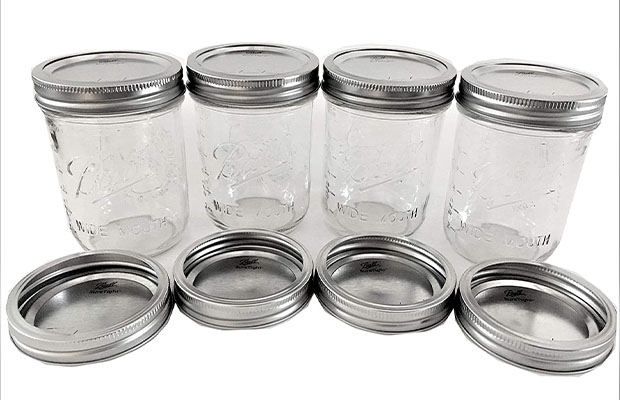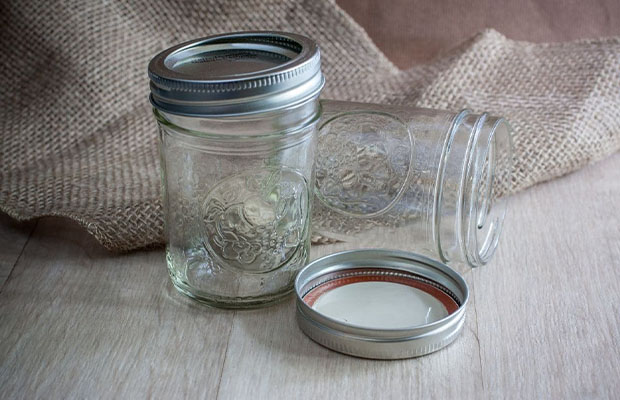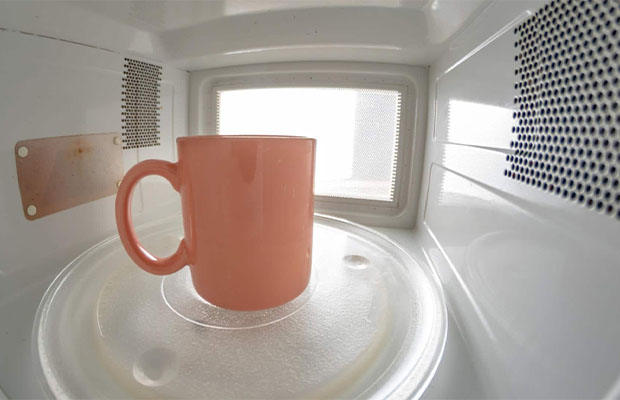Are Mason Jars microwave safe? Yes, newer jars are marked with a microwave-safe symbol. While not reactive, glass mason jars can still get very hot to the touch, so it’s important to keep that in mind.
Despite being non-reactive, microwave safe glass will absorb heat, making it risky to remove hot containers from your microwave.
Read on to learn when and how to microwave your mason jars, whether you’re using them to make a sourdough starter or to pickle red onion and cucumber.
Table of Contents
Can You Put Mason Jars In The Microwave?
The answer to this depends on a number of factors.
I detest these “it depends” responses, but there are a few things to look out for when microwaving Mason jars to ensure their safety.
Your Mason jars might or might not be microwave-safe.
Before putting your jar in the microwave, there are just a few things to keep in mind.
Related Reading:
Things To Consider
There are two things you need to consider before using it inside the microwave :
How Old Is Your Mason Jar?
The earlier versions of Mason jars are not microwave-safe. These have a thinner glass material composition.
Compared to earlier batches, the newer ones are more durable.
On the box, in the instruction manual, or under the cup, look for the microwave safe tag.
The mason jar shouldn’t be put inside your microwave if you can’t find it.

Which Temperature Would You Like To Use?
Although more recent Mason jars are microwave-safe, they are not sufficiently tempered to withstand exposure to high heat.
Specialized glass that has fewer air bubbles is called tempered glass. It offers thermal shock protection.
Mostly annealed glass is used to create the Mason jars. Up to a certain temperature, the microwave safe category can withstand thermal shock.
For a brief period of no more than two minutes, use them at low to moderate temperatures.
The Mason jars should not be heated above 400–450°F.
As you may be aware, microwaves heat food particles rather than cookware.
The glass can, however, get very hot if heat transfer occurs for a long time and at a high temperature. The Mason jar could break, explode, or crack open.
If it does, your microwave may be permanently damaged.
How To Determine Whether A Specific Mason Jar Is Microwave Safe?
Take a look at the jar’s base. If it is marked “microwave safe” on a sign, you can microwave it.
Another way to find out is to empty the jar of all its contents and microwave it for one or two minutes at low to medium power.
Use this method only for jars made of thick glass. If the glass Mason jar is thin and does not have a label that says “microwave safe,” do not try to microwave it using this method.
When Is It Improper To Microwave Mason Jars?
Don’t Microwave One That Doesn’t Have The “microwave-safe” Label
Don’t microwave something if there isn’t a microwave-safe symbol. The mess (and potential harm to your appliance or kitchen) if it explodes is simply not worth the risk.
Don’t Use A Mason Jar To Cook Food
Furthermore, only use mason jars for reheating food, not cooking it. Mason jars don’t hold food in a way that allows for even heating in the microwave, so some portions might not be fully cooked.
You won’t like the fact that it will continue to be cold in some places. Additionally, bacteria can survive in the uncooked portions and cause you to become ill.
Tips For Microwaving Mason Jars
Because the walls of the jar will contain heat and permit it to disperse throughout the food, using a mason jar to heat food can be very effective, especially when using low power settings.
However, the glass itself may get hot! (Especially if it’s colored glass)
Therefore, avoid removing it from the microwave with your bare hands. Use an oven mitt.
What About Other Appliance?
Dishwashing
Mason jars are easy to clean in the dishwasher. But frequent dishwashing might scratch the surface. To preserve the appearance of older jars, you might want to hand wash them.
Oven
Mason jars shouldn’t be used in the oven. Although empty jars can be sterilized in an oven, they shouldn’t be used for baking or cooking in the oven.
Freezing
A freeze line, which is embossed on the glass of some Mason jars, indicates the maximum amount of contents that can be frozen. Generally speaking, the product should be filled to just below the jar collar. As a result of the product expanding during freezing, glass cracking is prevented.
Conclusion
Do Mason jars work in the microwave? Generally speaking, yes; however, you must remove the lid.
In a microwave, be sure to use a thick glass. Avoid using it in hot conditions for an extended period of time. The contents inside can be reheated in no more than two to three minutes.
Don’t try it though if they don’t expressly have a microwave-safe symbol. Being safe with cold food is preferable to being sorry with a burning house.
FAQs
Can I Microwave Mason Jar Lid?
Metal is used to create the Mason jar’s lid. As time goes on, this metal corrodes.
Any product inside the jar is off-limits once it corrodes.
Avoid putting the metal inside the microwave because it will corrode there.
Always remove the lid before microwaving your Mason jar.
How Long Should I Microwave Mason Jars?
Mason jars should be microwaved for one to two minutes to sanitize them.
Use baking soda and vinegar or warm, soapy water to wash the jars. Wipe them dry.
A one-liter jar should be microwaved for one to two minutes.
Are Mason Jars Recyclable?
Annealed glass, which is recyclable, is used to make the majority of Mason jars. Rubber rings, however, cannot be recycled.
You can paint them and use them to store accessories, decorate rooms, etc. instead of recycling them.



MOST COMMENTED
How to
How to Clean Homedics Humidifier: Detailed Guide
How to
Are Humidifiers Good for Pneumonia? Complete Guide
How to
Can You Put Drano in a Dishwasher? (Facts & Safe Alternative)
How to
How to Turn Subtitles on Or Off on Peacock TV: 2023 Guide
How to
How to Get Rid of Hollow Arrow on iPhone? 2 Simple Ways
How to
How to Mirror iPhone to TV Without WiFi: Complete Guide
Computers, Tablets & Printers
The 5 Best Printers for Cricut in 2022